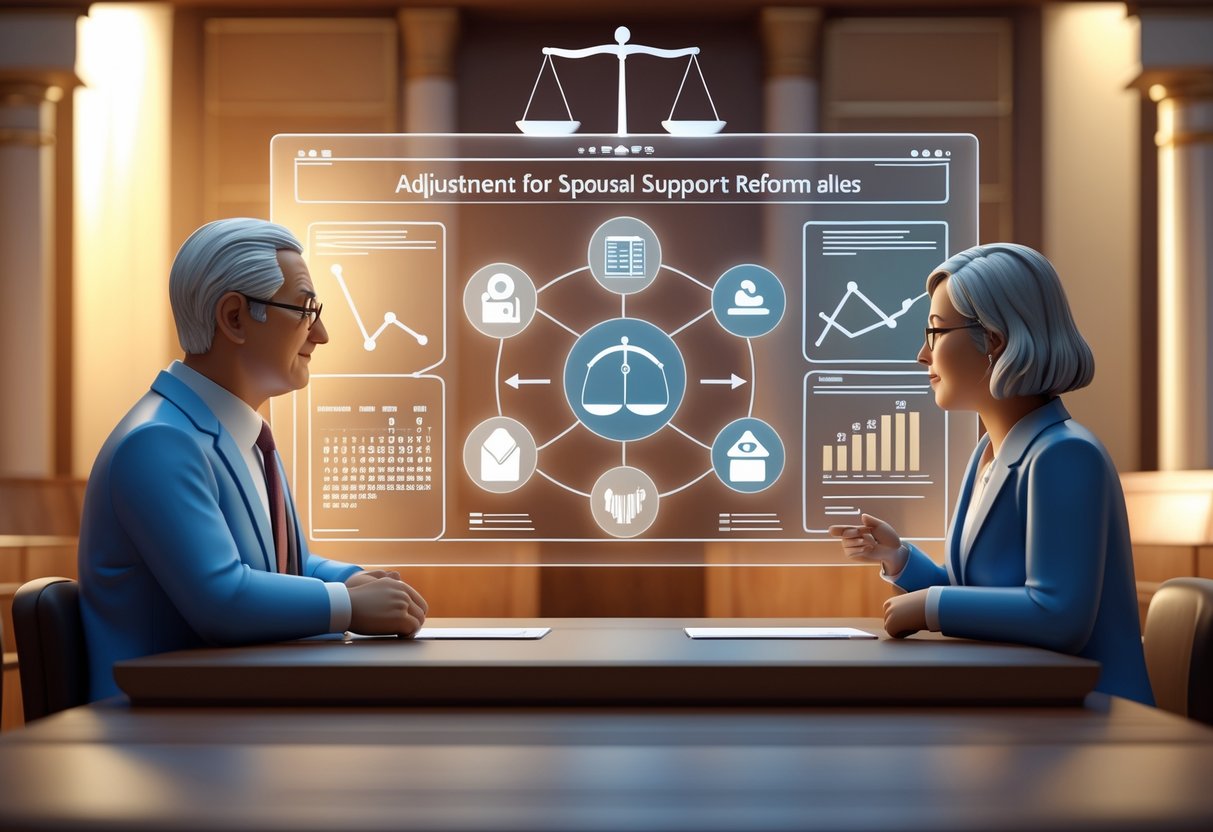Reform Proposals: Key Approaches, Policy Impact & Future Directions
Updated On: October 23, 2025 by Aaron Connolly
Understanding Reform Proposals
Reform proposals are basically structured plans to change current systems, policies, or institutions—whether in government, international groups, or other sectors.
People usually come up with these ideas when they spot problems and want more effective, fair, or efficient solutions through policy changes.
Types of Reform Proposals
You’ll find reform proposals in a few main categories. Each one tackles different parts of how things work.
Government and Political Reforms shake up how elections run and how power gets shared. Electoral College reform proposals try to make presidential elections more representative.
Usually, these include changes to voting methods or how we count votes.
Tax Reform Proposals are all about making taxes simpler. The flat tax idea would replace all those tax brackets with just one rate for anyone earning above a certain amount.
Supposedly, this makes filing easier, but it also changes who pays what.
Social Programme Reforms look at long-term challenges in benefits systems. Social Security reform proposals often mix several changes, like boosting benefits for some groups while cutting them for others.
International Organisation Reforms target big global institutions like the United Nations. People want to improve how these groups make decisions and become more transparent.
The goal? Help them respond better to climate change and human rights issues.
Historical Context of Reform
Reform proposals usually pop up when there’s a crisis or when people get fed up.
We’ve seen the same types of ideas come back again and again, just dressed up for a new decade.
Economic Pressures often spark these conversations. When government spending balloons or tax systems get too complicated, policymakers jump in with new proposals.
The 2008 financial crisis, for example, kicked off a whole wave of them.
Technological Changes open up new ways to run things. Digital voting and online tax filing have changed how people think about reforms.
Tech can breathe new life into old ideas.
Public Trust Issues really push reforms forward. When folks lose faith in institutions, reform proposals pick up steam.
Transparency and accountability measures get a lot of attention in these moments.
Every 10-15 years, reform cycles seem to repeat. The same proposals come back, tweaked to fit new tech and social values.
Current Debates and Major Stakeholders
Right now, the reform scene is crowded. Lots of groups want different things, and that explains why some proposals move forward while others get stuck.
Policymakers and Government Officials have to juggle a lot—voters, interest groups, and tight budgets.
Just look at Congressional fights over tax reform. It gets messy.
Citizens and Advocacy Groups push for changes that hit close to home.
Immigration reform pulls in support from both humanitarian and economic groups, but they rarely agree on what matters most.
Industry and Economic Players get involved when reforms affect business. Companies and trade associations weigh in on tax proposals.
They often shape the nitty-gritty details.
Academic and Policy Experts analyze whether reforms actually work.
Groups like the National Task Force on Rule of Law & Democracy offer nonpartisan takes. Their research helps lawmakers figure out if a proposal will do what it promises.
Lately, debates focus on fiscal responsibility, better representation, and global cooperation.
Climate change and new tech are making people realize old systems need updates.
Reform Proposals for Social Security
Social Security is running into a funding crisis that could drain its trust fund by the mid-2030s.
Lawmakers have thrown out all sorts of ideas, from raising taxes to cutting benefits. Honestly, the proposals split along party lines—Democrats want more revenue, Republicans focus on cutting spending.
Solvency Challenges in Social Security
The Social Security Trust Fund might run dry between 2033 and 2035.
After that, the system could only pay about three-quarters of promised benefits with current tax revenue.
Why’s this happening? Demographics. More people retire, fewer workers pay in.
Right now, Social Security pays out more than it collects.
If Congress doesn’t act, millions will see automatic benefit cuts.
That’s got people on both sides of the aisle calling for action.
The Social Security Administration puts out regular reports analyzing these proposals.
Lawmakers rely on these numbers to see how each plan would affect Social Security’s future.
Recent Legislative Initiatives
Lawmakers have tried a bunch of different approaches lately.
Senator Mazie Hirono introduced the “Protecting and Preserving Social Security Act” in August 2025.
Representative Gwen Moore came up with the “Social Security Enhancement and Protection Act of 2025.”
President Trump signed the “One Big Beautiful Bill Act” in July 2025, which included Social Security changes.
Actuaries have already weighed in on the financial impact.
Representative Angie Craig keeps bringing back the “You Earned It, You Keep It Act.” Since 2022, she’s introduced multiple versions.
Rodney Davis and Representative Abigail Spanberger teamed up for the Social Security Fairness Act of 2021. That bill tried to get rid of provisions that reduce benefits for some public servants.
Bipartisan and Partisan Approaches
Democrats usually want to expand benefits and bring in more money.
They suggest raising the payroll tax cap or adding new taxes for higher earners.
The goal is to boost retirement security for people who need it most.
Republicans, on the other hand, focus on keeping spending in check.
They might propose raising the retirement age or means-testing benefits for the wealthy.
They’re more concerned about long-term sustainability than benefit levels.
Sometimes, lawmakers from both sides work together.
Senators Ron Wyden and Bill Cassidy teamed up on the “Work Without Worry Act.” That shows there’s at least some room for compromise.
Mixed proposals try to balance things out—some revenue increases, some benefit tweaks.
It’s all about spreading the impact between current and future retirees while keeping the program afloat.
Public Perceptions and Trust
Americans have mixed feelings about these reforms.
Polls show people prefer raising revenue over cutting benefits.
Most don’t want any changes that hurt today’s retirees.
Trust in Social Security’s future is shaky, especially among younger workers.
A lot of them worry they’ll never see the benefits they’re promised.
There’s also a knowledge gap.
Many folks don’t know the difference between cutting benefits and ending the program altogether, which makes it tough to build support for any plan.
Politicians often talk up the crisis but don’t offer clear solutions.
That just ramps up anxiety and doesn’t get us any closer to agreement.
Honestly, a more honest conversation about shared goals—like keeping Social Security strong—would probably help.
Raising the Retirement Age
Republican lawmakers want to gradually push Social Security’s full retirement age from 67 up to 69 or even 70 by 2033.
This move would cut benefits for all future retirees by about 13-20 percent, no matter when they claim.
Arguments for Age Increases
Republicans say raising the retirement age matches up with people living longer and helps keep Social Security solvent.
The Republican Study Committee pitched bumping the full retirement age to 69 by 2033.
Supporters argue this avoids even bigger automatic cuts.
If the trust funds run out, everyone faces a 23 percent cut. Raising the age to 70 would mean about a 20 percent cut, but only for new retirees.
Their main points:
- Life expectancy at 65 has gone up by almost three years since 1983.
- People can work longer than before.
- Gradually phasing it in gives future retirees time to plan.
- Current retirees keep their benefits while the system gets shored up.
These proposals usually protect people already getting benefits or those close to retirement.
Only workers born after 1960 or so would see changes.
Impact on Future Retirees
Raising the retirement age is basically a benefit cut across the board.
Every year you add to the full retirement age slices about 7 percent off monthly benefits for everyone affected.
People who claim at 62 get hit hardest.
Right now, they get 70 percent of their full benefit. If the retirement age jumps to 70, early claimers would only get 57 percent.
Here’s how it plays out:
- Current law (age 67): £1,400/month at age 62
- Proposed (age 70): £1,140/month at age 62
- That’s £260 less per month, for life
These cuts hit lower-income workers the hardest, since they rely most on Social Security.
For people who depend solely on Social Security, a 20 percent cut is a 20 percent drop in total income.
A lot of early retirees can’t just keep working due to health problems, layoffs, or family needs.
Nearly 30 percent of workers claim at 62, the earliest age allowed.
Life Expectancy and Policy Justifications
Sure, average life expectancy has gone up, but not for everyone.
Higher-earning men outlive lower-earning men by more than five years, and that gap keeps growing.
Life expectancy at 65 by group:
- White: 19.5 years
- Black: 18.2 years
- Hispanic: 21.6 years
- Asian: 23.4 years
The poorest 40 percent of women actually live shorter lives than women in previous generations.
About 40 percent of people in their early sixties report possible disabilities, though less than half get disability benefits.
Most of the gains in life expectancy have gone to higher earners, whose incomes also grew faster.
That makes raising the retirement age especially tough for working-class Americans who haven’t seen these improvements.
Lately, life expectancy has dropped thanks to the pandemic and problems like opioid deaths.
That really undercuts the argument that longer lives justify benefit cuts through higher retirement ages.
Means-Testing and Progressive Price Indexing

Republican proposals target benefit reductions for middle and higher earners using two main strategies.
These changes would really shift how the Social Security trust fund figures out benefits for future retirees.
Progressive Price Indexing Explained
Progressive price indexing would totally change how we calculate Social Security benefits for new retirees.
Instead of tying benefits to wage growth, this system would link them to slower-rising prices for most workers.
Right now, benefits grow with average wages, so each generation gets benefits that reflect today’s living standards.
With progressive price indexing, only the lowest 30% of earners would keep this wage-based system.
Middle and higher earners would see their benefits tied to price growth instead.
Since prices usually rise slower than wages, this means benefit cuts get bigger over time.
Here’s how the tiers break down:
- Bottom 30%: Keep current wage-based benefits.
- Top earners: Benefits get frozen at a fixed purchasing power.
- Everyone else: A mix of both formulas.
By 2080, these changes could slash benefits by about 30% for average earners and up to 50% for higher earners compared to current law.
Targeted Benefit Reductions
Means-testing would directly cut or eliminate benefits for people with moderate or higher incomes.
The Republican Study Committee’s budget wants to use “progressively price-indexed” formulas to make these cuts.
Workers making around £34,000 a year and up would feel the pinch.
Even those with modest incomes could see big reductions under most proposals.
The idea is to focus Social Security resources on lower-income retirees and save money for the trust fund.
But, this weakens the connection between what workers pay in and what they get back.
Social Security benefits aren’t exactly generous now.
The average benefit is only about £11,000 a year.
Most retirees rely on Social Security for three-quarters or more of their income, so these cuts would really sting.
Adjustments to Survivor Benefits and Spousal Support

Some recent reform proposals try to strengthen survivor benefits by getting rid of penalties that cut payments for certain groups.
These changes would help tackle elder poverty by making sure widows and surviving spouses get fair financial support.
Proposed Changes to Survivor Benefits
The Government Pension Offset (GPO) has long cut survivor benefits for people who get pensions from jobs outside Social Security. Right now, these cuts often wipe out benefits completely.
Key reforms include:
- The government will fully scrap the GPO for survivor benefits.
- Surviving spouses will get full payments based on their late partner’s earnings.
- Social Security will automatically process back payments for anyone who lost out before.
Surviving spouses of public sector workers will feel the biggest change. Teachers, police, and firefighters who lost benefits because of their government pensions will finally get the full amount.
These changes kick in starting 2025. People don’t need to fill out extra forms—the Social Security Administration will handle the adjustments.
Payment timeline:
- New benefit amounts begin in January 2025.
- Retroactive payments arrive by March 2025.
- Back pay covers any reductions since January 2024.
Implications for Elder Poverty
These survivor benefit changes go right after elder poverty, especially for widows and surviving spouses. Many folks struggle after losing a partner’s income and then get hit again by reduced Social Security.
The new rules will bring real relief. Some survivors who barely got by will see their payments jump by hundreds or even thousands every month.
Financial impact areas:
- Housing costs should get easier to manage.
- Covering healthcare bills won’t feel so impossible.
- Just keeping up with daily living will get less stressful.
Public sector workers’ spouses benefit most here. These families faced the toughest cuts, despite years of public service.
The reforms also help people who worked both public and private jobs. Now, they’ll finally get the full survivor benefit their spouse earned under Social Security.
Studies have shown widow poverty is still far too common, especially among older women. With these changes, thousands of surviving spouses could see a big drop in financial hardship.
Administrative and Funding Reforms
Recent proposals put Social Security Administration operations under the microscope, calling for budget cuts and technology upgrades. The idea is to make things run smoother and cheaper—but that’s easier said than done.
Social Security Administration Budget Cuts
Right now, the Social Security Administration faces some serious budget pressure. Budget reductions could shrink staff and slow down services.
If these cuts go through, people may wait longer for their benefits. Some field offices might even cut hours or shut down in certain places.
The agency processes millions of claims every year. With less money, they’ll have a tough time keeping up with disability decisions and appeals.
Staff reductions could save the most money. But let’s be honest, that risks hurting service quality.
Some lawmakers want to merge regional offices to save cash. That could mean fewer local options for help, though.
Older adults and people with disabilities often need in-person help. Budget cuts could leave them stranded.
Operational Modernisation Proposals
Tech upgrades sit at the heart of modernization plans. Digital transformation aims to ditch paperwork and manual processing for good.
New online portals would let people check their benefits and upload documents from home. That should speed things up and lighten the load for staff.
Artificial intelligence could handle simple claims faster. The system would send trickier cases to real people, but routine stuff could move automatically.
Data integration between agencies is another big step. If government offices share info, people won’t have to fill out the same forms over and over.
Mobile-friendly apps could help younger folks get what they need. But making sure older adults can use these tools is still a real challenge.
Cybersecurity is a must. Protecting sensitive info means spending more on strong digital defenses.
Staff will need new training to keep up with all this tech. Investing in people is just as important as new systems.
Election and Political System Reform Proposals

Congress keeps debating big bipartisan bills like the American Confidence in Elections Act and the Freedom to Vote Act. Both could change how Americans register and vote. Meanwhile, the Electoral College faces more pressure than ever, from the National Popular Vote Interstate Compact to calls for constitutional amendments.
Bipartisan Federal Election Reform Ideas
The Bipartisan Policy Center picked out four areas where both parties might actually work together. These are casting ballots, voter registration, voter identification, and certification.
Ballot Access and Security A compromise would make states offer no-excuse mail voting and at least seven days of in-person early voting. Democrats get more access, Republicans get signature checks and mail ballots must arrive by poll close.
List Maintenance Standards Both sides want cleaner voter rolls, but they fight over how to do it. A middle-ground approach would encourage automatic and online registration, plus set national standards for list maintenance and reporting.
The American Confidence in Elections Act, first introduced by Rodney Davis, zeroes in on election security. It would require signature checks for mail ballots and only count ballots received by the deadline.
Voter Registration and Cast Ballot Reforms
Registration Modernisation Twenty-two states use automatic voter registration now, and 42 have online sign-up. These systems cut down on mistakes and keep voter lists more accurate than old-school paper forms.
Same-day registration remains a sticking point. Some states worry about verifying voters who show up and register right before voting.
Voter Identification Standards Current proposals would set a national voter ID rule, but allow non-photo options like utility bills or bank statements. This tries to balance security with access.
Provisional ballots let people without full ID still vote. If they prove eligibility later, their vote counts. This keeps eligible voters from getting shut out by paperwork.
Electoral College Changes
National Popular Vote Interstate Compact This plan would skip the Electoral College without changing the Constitution. States promise to give their electoral votes to whoever wins the national popular vote, once enough states join to hit 270.
Direct Election Amendments Some amendments would just get rid of the Electoral College entirely. But that takes two-thirds of Congress and three-fourths of state legislatures—no small feat.
Proportional Allocation Other ideas would keep the Electoral College but ditch the winner-take-all rule. States would split their electoral votes based on actual vote totals.
With the current winner-take-all setup, candidates focus on swing states and pretty much ignore the rest.
Congressional and Legislative Reform Efforts

People keep pushing to change how Congress works, from new procedures to stricter accountability and even big structural shake-ups. The hope is to make lawmakers more effective—and maybe a little more in touch with regular folks.
Filibuster Reform Concepts
The filibuster lets senators stall or block votes by dragging out debate. It’s gotten pretty controversial since it can stop a majority from acting.
Several ideas are floating around. The most popular? Make senators actually talk on the floor to keep a filibuster going. Right now, they just threaten it and go home.
Another idea would lower the vote threshold for ending debate. Instead of 60 votes, maybe 55, or even a sliding scale that drops over time.
Getting rid of the filibuster altogether would be the boldest move. Supporters say this would let the majority actually govern.
Critics warn that if you scrap it, the Senate could swing wildly with every election. They see it as a shield for the minority.
Strengthening Legislative Accountability
Ethics reforms want to make Congress more transparent and less conflicted. Lawmakers need to win back some public trust.
Trading restrictions would limit how members invest while in office. Some want to ban stock trading outright; others just want longer disclosure or blind trusts.
Campaign finance changes target special interests. Ideas include stricter donation limits and better lobbyist reporting.
Term limits keep coming up. These would cap how long someone can serve and maybe bring in some new faces.
Disclosure requirements would force lawmakers to share more details about their finances and report conflicts faster.
Structural Proposals for Congress
Budget process reforms try to fix Congress’s habit of breaking its own spending rules. The current system often collapses into last-minute deals or threats of shutdown.
Biennial budgeting would switch to two-year cycles. That might bring more stability and free up time for oversight.
Committee restructuring could cut down on overlap and boost efficiency. Some want to merge similar panels or change how lawmakers get assigned.
Leadership reforms might change how party leaders get picked and what they can do. Some proposals would cap terms for Speakers or give regular members more say.
Modernisation means updating tech and allowing more flexible work. Congress desperately needs to catch up with the digital world.
Policy Proposals for Economic Stability

When countries run into financial trouble, they need a clear way out. Recent debt crises have shown that waiting only makes things uglier for everyone.
Addressing Debt Sustainability
Debt can spiral out of control fast if countries can’t pay their bills. The trick is spotting trouble early—before things explode.
Debt sustainability analysis helps governments see if their debt load is manageable. This means looking at income, spending, and growth.
Key factors:
- How much revenue covers debt payments
- Growth rates
- External debt
- Currency stability
If debt gets out of hand, countries usually have to make hard choices. That could mean spending cuts, higher taxes, or turning to international lenders.
The International Monetary Fund often steps in with emergency help, but they always attach strings.
Jumping on problems early works better than waiting. Countries that move fast usually have an easier time adjusting.
Sovereign Debt Restructuring Reforms
Lately, debt restructuring drags on far too long. These delays hurt everyone—the country, its people, and creditors waiting for their money.
The main issues are slow decisions and creditors who can’t agree. Some hold out for better deals while others take losses.
New reform ideas hope to speed things up. The IMF wants to make it easier for countries to get help during restructuring.
Key reforms include:
- Faster emergency funding approval
- Better coordination among creditors
- Clearer debt sustainability guidelines
We have to balance creditor rights with helping countries recover. If restructuring drags on, debt problems just get worse.
The aim is to restore countries to medium-term external viability—basically, so they can pay their debts without constant panic.
International Reform Proposals and Global Implications

Major reform efforts are shaking up how global institutions work together these days. The IMF leads the charge to help developing countries get better financing, and successful reforms elsewhere offer lessons even for the esports world.
IMF Policy Reform Initiatives
The IMF is shaking up its lending rules to make getting money easier and faster. Flexibility is the name of the game now.
New Lending Approaches
The IMF has rolled out the Resilience and Sustainability Trust. This fund helps countries handle climate issues and other big shocks.
They’re also changing how they check if countries can repay. Old methods ignored climate risks and were just too rigid.
Representation Changes
Developing countries now get more influence at the IMF. African nations, for example, secured a third seat on the executive board.
The quota system is changing too. That system decides who gets how much voting power.
Key Reform Areas:
- Faster loans
- Smarter risk checks
- More flexible terms
- More voice for developing countries
Lessons from Global Reform Practices
Other countries have tried all sorts of reforms, and their experiences can teach us a lot. We can use these lessons to shape future changes in different sectors.
Successful Reform Strategies
The Bridgetown Initiative really stood out by keeping things straightforward. Instead of overwhelming everyone with dozens of ideas, they stuck to just five clear proposals.
Coalitions play a big role, too. The V20 group now brings together 68 countries—that’s about 1.7 billion people. With those numbers, they actually have the clout to demand real change.
Common Challenges
Having too many proposals just muddles things. At one point, experts counted 71 separate reform ideas out there. That kind of overload just scatters focus.
Political timing makes or breaks reforms. If a window opens, countries have to act quickly—those chances don’t last long.
What Works:
- Simple, focused proposals
- Strong coalitions of countries
- Zeroing in on the biggest impact
- Moving fast when political moments pop up
Evaluating Impact and Effectiveness of Reform Proposals

When we look at reform proposals, we can’t just go by good intentions. Real results matter most.
We have to see what actually changes when reforms roll out, and figure out what gets in the way. Even well-designed plans can fall flat if we ignore the real-world obstacles.
Measuring Policy Outcomes
We measure policy outcomes by checking three things: effectiveness, efficiency, and equity. Each one tells a different part of the story.
Effectiveness is pretty basic—does the policy do what it promised? If a reform claims it’ll cut pollution, we check if emissions really drop. Sometimes, we also notice side benefits like better health or cleaner air.
The best way to judge effectiveness is with randomised controlled trials. We compare people who get the new policy to those who don’t. If that’s not possible, we use before-and-after snapshots.
Efficiency asks if the results are worth the cost. We lean on cost-benefit analysis for this. It’s all about what we spend versus what we get back.
Sometimes, effectiveness and efficiency don’t line up. Expanding a successful pilot might help more people, but it could also cost more per person.
Equity looks at who pays and who benefits. This one’s tricky but just as important. We want to know if a reform shrinks inequality or makes things worse.
| Measure | Key Question | Main Tool |
|---|---|---|
| Effectiveness | Does it work? | Randomised trials |
| Efficiency | Is it worth the cost? | Cost-benefit analysis |
| Equity | Who wins and loses? | Demographic analysis |
Challenges in Implementation
Even the best reforms hit snags on the ground. We keep seeing the same roadblocks pop up.
Resource constraints often stop reforms in their tracks. Policymakers sometimes underestimate the money, staff, or time needed. A plan might look great on paper but fizzles without enough support.
Resistance from stakeholders can really slow things down. People who benefit from the current setup—like government workers or businesses—tend to fight changes that threaten them.
Coordination problems show up when different agencies or levels of government have to work together. Priorities clash, or communication breaks down.
Unintended consequences come out of nowhere. Fixing one problem sometimes creates another. We need ways to spot these surprises early.
Timeline mismatches frustrate everyone. Politicians want quick wins, but real change usually takes years to show up.
Planning for these headaches from the start gives reforms a better shot at success.
Future Directions for Reform Proposals

Reform proposals are moving past old-school government processes. Now, we see new ideas like fiscal commissions and automated systems for putting plans into action.
Stakeholders need to get comfortable with new technology and fresh ways to work together. Transparency and clear results are becoming the new priorities.
Emerging Trends in Policy-Making
These days, reformers use data to tackle tough problems. The BRAC-style fiscal commission is a good example—experts handle tricky decisions and keep politicians out of the direct line of fire.
Technology’s influence keeps growing. Digital tools let us track progress and measure results as they happen. That level of accountability just wasn’t possible before.
Bipartisan cooperation tends to happen when reforms give clear, immediate benefits. Universal health accounts are a case in point—workers see a direct financial boost, no matter their politics.
Cross-sector teamwork is now essential. Immigration reform, for example, needs employers, schools, and government to work together if we want to match skills with jobs.
Recommendations for Stakeholders
Policymakers should set clear, trackable goals for reforms. Vague promises get lost—specific targets help everyone see what’s working.
Private sector involvement is vital. Employers gain from immigration reforms that fill skill gaps, and financial firms can make universal savings accounts attractive.
Citizens deserve information that makes sense in their day-to-day lives. The best proposals break things down into real-world benefits, like higher pay or lower health costs.
Reformers should build coalitions around shared economic interests, not just party lines. That kind of support sticks around, even when leadership changes.
Frequently Asked Questions

People have plenty of questions about how reforms work and what they mean for everyday life. Let’s dig into some of the most common ones about parliamentary changes, government successes, and the effects of reform movements.
What suggestions are there for rejuvenating parliamentary procedures?
A few big ideas are on the table for modernising Parliament. Digital voting could speed things up, cutting down on endless yes-no sessions.
Some experts want committees to have more power and time to review bills. That would mean fewer rushed laws and better decisions.
Flexible hours are getting attention, too. Parliament could meet at times that suit today’s work patterns, not just tradition.
Others want to crack down on filibustering and similar tactics. That way, important debates can move forward without getting bogged down.
Can you tell us about any recent examples of successful reforms in government?
Property assessing reform stands out as a success. In 2018, new rules gave local councils clear standards for valuing homes for taxes.
Now, regular audits and checks keep things fair. Homeowners get better assessments, and councils know what’s expected.
Wildland firefighter pay reforms made a difference, too. The 2024 budget gave permanent raises to federal firefighters who protect communities.
Thanks to these changes, fire services can finally compete for talent and keep experienced staff on board.
What are the latest developments in the Congressional Reform Act of 2025?
As of August 2024, the Congressional Reform Act of 2025 is still in the works. Lawmakers are talking about tougher transparency and accountability rules.
Early drafts include stronger ethics enforcement and clearer conflict-of-interest policies. These changes could help rebuild public trust.
Committee reform is a big focus, aiming for more efficient work and fairer representation of different viewpoints.
Digital upgrades look likely, too. Congress might finally get modern tech and better communication tools.
Which reforms are currently considered essential for our society?
Simplifying the tax system tops the list for many. Right now, complicated rules cost everyone time and money.
Criminal justice reform is urgent, especially for non-violent offenses and better rehab programs.
Healthcare reforms aim to lower costs but keep up quality. Prescription drugs and insurance gaps are big targets.
Education funding reform focuses on fairness. The goal is to give all kids a quality education, no matter where they live.
How might we see the Senate evolve with proposed legislative changes?
Changing the filibuster could have the biggest impact. Some plans would force senators to actually speak nonstop to block a bill.
Committee reforms might give smaller states more say on big issues. That could help balance rural and urban interests.
Term limits for committee chairs would shake up power. Instead of seniority ruling everything, leadership could rotate more often.
Better transparency could make Senate business easier for regular people to follow. Live streams and improved records would help everyone keep track of debates.
What lasting impacts have reform movements from the progressive era had on today’s governance?
The direct election of senators really changed how the upper house functions. Before 1913, state legislatures picked senators, and that often led to corruption or shady backroom deals.
The initiative and referendum processes still give citizens a way to shape state-level democracy. People can propose new laws directly or overturn unpopular ones through ballot measures.
Civil service reforms brought in merit-based hiring for government jobs. This shift ended the old habit of letting political connections outweigh actual qualifications.
Regulatory agencies, like the Food and Drug Administration, got their start during the progressive era. These organizations still work to protect consumers today.
Municipal reforms also left a mark by introducing professional city management. Many city councils still rely on city managers instead of just political leaders.

